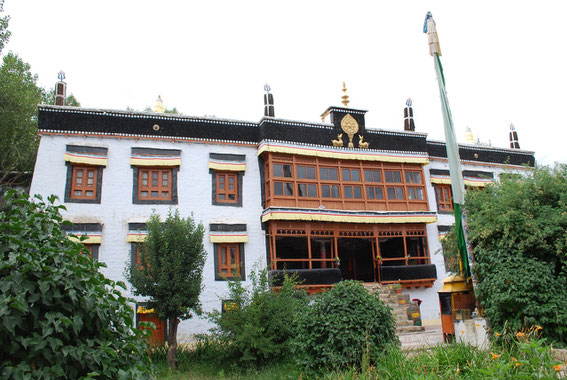Samkar - RATNA VOYAGES: Incredible India - Incredible Ladakh!
SAMKAR MONASTERY, LEH - LADAKH

|
NAME/NOM/ NAME/NOME |
SAMKAR GOMPA SAMKAR CHOSKOBLING |
|
|
LOCATION/LIEU/ ORT/LUOGO |
Leh | |
|
LINEAGE/TRADITION/ SCHULE/ORDINE |
Gelug-pa |
|
|
FOUNDED/FONDÉ/ GEGRÜNDET/FONDATO |
18th Century |
|
|
FOUNDER/FONDATEUR/ GRÜNDER/FONDATORE |
Venerable Kushok Bakula |
|
|
|
||
|
PROTECTOR/PROTECTEUR/ SCHIRMHERR/PROTETTORE |
Palden Lhamo |
|
|
SPIRITUAL HEAD/ MAÎTRE SPIRITUEL/ GEISTIGES OBERHAUPT/ CAPO SPIRITUALE |
Ven. 20th Kushok Bakula Rimpoche |
|
|
|
Official residence of the Head Lama of Ladakh Ven. Kushok Bakula Rimpoche |
|
|
BRANCH/AFFILIÉ/ ZWEIG/AFFILIATO |
Spituk Monastery |
SAMKAR Gompa -
SAMKAR Gompa
is situated in a field just 3Km from Leh Main Market. It belongs to Spituk Monastery of Gelugpa sect and it is the official residence of the Head Lama of Ladakh, Ven. Kushok Bakula of Spituk Gompa.
The Monastery has beautiful wall paintings of different deities, protectors and the rules for the monks mentioned in the Vinaya texts are depicted. The main deity of the monastery is thousand armed Dugkar (Sitatapatra).
Samkar Gonpa, also known as Samkar Monastery, is a Buddhist monastery located in Leh, Ladakh. Here is a detailed history of Samkar Gonpa:
SAMKAR Gompa - Foundation and Early History
Samkar Monastery is one of the lesser-known monastic institutions in Ladakh.
The exact date of its foundation is not widely documented, but it is believed to have been established several centuries ago.
SAMKAR Gompa - Spiritual Tradition
Like many monasteries in Ladakh, Samkar Gonpa follows the Tibetan Buddhist tradition, particularly the Gelugpa sect.
SAMKAR Gompa - Architectural Features
The monastery features traditional Tibetan architecture with white walls and colorful frescoes.
It consists of prayer halls, stupas, and residences for the resident monks.
SAMKAR Gompa - Religious Art and Artifacts
The interiors of the monastery are adorned with Buddhist murals, thangkas, and statues.
There may be valuable artifacts such as scriptures, ritual implements, and ancient relics preserved within the monastery.
SAMKAR Gompa - Spiritual Practices
Samkar Gonpa serves as a place of worship, meditation, and religious education for monks.
The monks residing in the monastery engage in daily rituals, prayers, and ceremonies.
SAMKAR Gompa - Cultural Significance
While not as prominent as some of the larger monasteries in Ladakh, Samkar Monastery contributes to the cultural and spiritual tapestry of the region.
SAMKAR Gompa - Role in the Community
Monasteries in Ladakh often play a crucial role in the local community, providing spiritual guidance, education, and participating in social events
SAMKAR Gompa - Visitors and Pilgrims
Samkar Monastery may attract visitors, tourists, and pilgrims interested in exploring the religious and cultural heritage of Ladakh.
SAMKAR Gompa - Annual Festivals
Like many monasteries in the region, Samkar Gonpa may celebrate annual festivals with traditional rituals, mask dances, and cultural performances.
While Samkar Monastery may not be as widely recognized as some of the larger monastic institutions in Ladakh, its historical and cultural significance contributes to the overall richness of the Buddhist heritage in the region.
SAMKAR Gompa - Architectural Features
The monastery features traditional Tibetan architecture with white walls and colorful frescoes.
It consists of prayer halls, stupas, and residences for the resident monks.
SAMKAR Gompa - Religious Art and Artifacts
The interiors of the monastery are adorned with Buddhist murals, thangkas, and statues.
There may be valuable artifacts such as scriptures, ritual implements, and ancient relics preserved within the monastery.
SAMKAR Gompa - Spiritual Practices
Samkar Gonpa serves as a place of worship, meditation, and religious education for monks.
The monks residing in the monastery engage in daily rituals, prayers, and ceremonies.
SAMKAR Gompa - Cultural Significance
While not as prominent as some of the larger monasteries in Ladakh, Samkar Monastery contributes to the cultural and spiritual tapestry of the region.
SAMKAR Gompa - Role in the Community
Monasteries in Ladakh often play a crucial role in the local community, providing spiritual guidance, education, and participating in social events.
SAMKAR Gompa - Visitors and Pilgrims
Samkar Monastery may attract visitors, tourists, and pilgrims interested in exploring the religious and cultural heritage of Ladakh.
SAMKAR Gompa - Annual Festivals
Like many monasteries in the region, Samkar Gonpa may celebrate annual festivals with traditional rituals, mask dances, and cultural performances.
While Samkar Monastery may not be as widely recognized as some of the larger monastic institutions in Ladakh, its historical and cultural significance contributes to the overall richness of the Buddhist heritage in the region.








